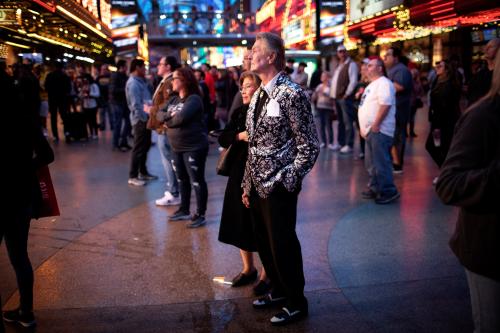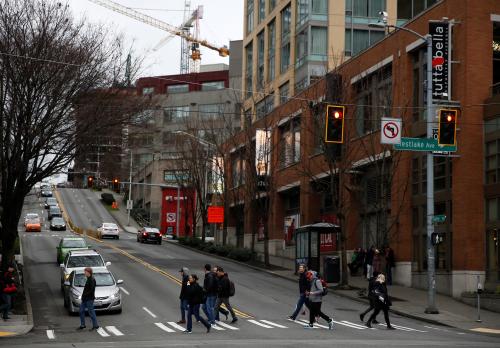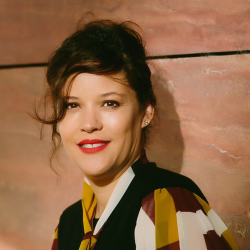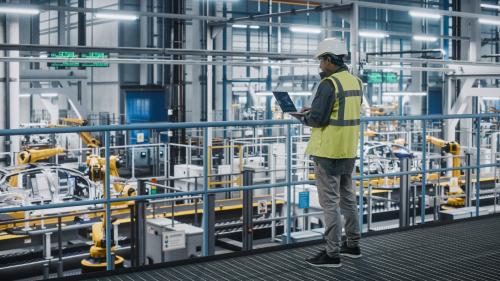As health organizations, governments, companies, and others continue to work toward solutions for the COVID-19 pandemic, we are reminded that this type of global, real-time coordination doesn’t happen in isolation. It’s through networks of small geographies of innovation—areas of advanced research, rapid prototyping, and commercialization—that progress is made.
Since the outbreak began, these “innovation districts” have been leveraging their assets to better understand and mitigate COVID-19’s impacts. These assets include pools of highly trained academic researchers, essential innovation infrastructure such as laboratories with specific biosafety standards, the advanced technologies and Big Data needed for modeling, and a network of local and global peers that help illuminate the complexities of the virus.
In light of the crisis, the Global Institute on Innovation Districts asked innovation districts around the world to what extent their research institutions, R&D labs, companies, and other actors are advancing research on COVID-19, including the development of a vaccine. We targeted districts focusing on the broad sector of life sciences (rather than those specializing in epidemiology, immunology, and/or infectious diseases) in an effort to include all research specializations that have been tapped to address the pandemic.
Seven innovation districts shared their current and deepening engagement on COVID-19. Described below are highlights of their work.
The Melbourne Innovation District, which includes the Melbourne Biomedical Precinct, is recognized for its high concentration of major universities, hospitals, medical research institutes, and industry. A global leader in immunology and the study of study infectious diseases, this district played an instrumental role in the early stages of the outbreak, helping advance our collective understanding of COVID-19. The Peter Doherty Institute for Infection and Immunity, an institute established through a partnership between the Royal Melbourne Hospital and the University of Melbourne, has played a leading role in several ways:
- Scientists from the Royal Melbourne Hospital’s Victorian Infectious Diseases Reference Laboratory at the Doherty Institute were the first outside of China to grow COVID-19 in a laboratory. At the end of January, the Doherty Institute was first to share these samples with public health laboratories nationally and globally.
- In early March, the Jack Ma Foundation awarded the Doherty Institute $3.2 million Australian dollars ($2.15 million in U.S. dollars) to expedite research of a vaccine for COVID-19 and its readiness for human trials.
The Milan Innovation District (MIND), while still under development, will include cutting-edge research in life sciences, advanced technologies, and health and nutrition. Led by a government collaboration called Arexpo and the development company Lendlease, MIND is in the advanced stages of transforming the site of Italy’s 2015 EXPO exhibition into a hotbed of innovation. The district’s anchors—which include the Statale University of Milan, the Human Technopole (a research institute for life sciences), and the Galeazzi Hospital—are currently advancing joint research activities. Teams of researchers in this area of northern Italy are using their particularly challenging circumstances to inform their work:
- Researchers from the Statale University’s Department of Biomedical and Clinical Sciences and Sacco Hospital completed the isolation of three coronavirus strains currently circulating in the Codogno area (a town close to Milan where the first outbreak was registered). The team is now analyzing additional genomes to better understand when the virus entered the country and how it spreads.
- The University of Milan Statale has established a special fund to sponsor research projects that could provide rapid results to help address the current emergency.
- The Italian member of the World Health Organization and chair of the Human Technopole Scientific Board is driving efforts to increase access to reliable and centralized data sources for informing public policies.
- Researchers at the Galeazzi Hospital are working with policymakers and industry on developing an early technology assessment to speed up “horizon scanning” (a process used for detecting early, but important, developments) of newly proposed in vitro diagnostics, medical devices, and vaccines to combat COVID-19.
The Cortex Innovation Community in St. Louis is a robust innovation community underpinned by several life science research institutions, including Washington University, Saint Louis University, and the Barnes-Jewish Hospital. Saint Louis University is one of nine Vaccine Treatment Evaluation Units (VTEUs) in the United States. Established by the National Institute of Allergy and Infectious Diseases, the VTEU network has played a key role in developing new and improved infectious-disease vaccines for over four decades. Experts in St. Louis shared that the VTEU network is involved in a multisite COVID-19 treatment trial, and that work has accelerated in St. Louis over the past week. Other advancements within this district include:
- The testing of several vaccine candidates.
- Research to isolate neutralizing antibodies to the virus, allowing those antibodies to be scaled up for production.
- Research to develop diagnostic assays using animal models of the disease to obtain data on the basic biology of the virus.
- Efforts on the part of the spatial health arm of the Geospatial Institute to better predict and prepare areas and populations with the highest need.
The Hagastaden Innovation District in Stockholm is a growing area of innovative and international research anchored by three universities (the Karolinska Institutet, KTH Royal Institute of Technology, and Stockholm University) and by Karolinska University Hospital. It is also home to 120 life science and health tech companies. Their work on COVID-19 to date includes:
- In early March, the Karolinska Institutet was awarded three of the 17 European Union-funded projects to research the virus. These projects aim to find a vaccine, immunotherapies, and neutralizing antibodies for COVID-19.
The Pittsburgh Innovation District is a fast-growing innovation district with a constellation of strong research institutions: Carnegie Mellon University, the University of Pittsburgh, and the University of Pittsburgh Medical Center, which is the largest academic medical system in the country. The University of Pittsburgh School of Medicine’s Center for Vaccine Research is leading the study of COVID-19:
- The Center for Vaccine Research recently received a sample of COVID-19. Their research on it will occur in one of the 12 federally designated Regional Biocontainment Laboratories in the country. Specific research efforts will include the development of disease models, which will be used to develop a vaccine.
Copenhagen Science City is an innovation district in the heart of the Danish capital that is anchored by the University of Copenhagen, University Hospital Rigshospitalet, and University College Copenhagen:
- The University of Copenhagen—in collaboration with the University of Tübingen, Leiden University Medical Center, Wageningen University, and two companies—is in the process of using a previous vaccine technology they developed as a platform for a COVID-19 vaccine. In early March, the consortium received a grant of 2.7 million euros ($3.06 million) from the European Union.
The Knowledge Quarter and St Mary’s Hospital Campus in London are nationally recognized as powerhouses of innovation, boasting a research specialization in emerging infectious diseases. In the Knowledge Quarter, the concentration of leading research institutions includes the London School of Hygiene & Tropical Medicine, University College London, the Royal Veterinary College, and the Francis Crick Institute. The St Mary’s Hospital Campus includes Imperial College MRC and the Abdul Latif Jameel Institute for Disease and Emergency Analytics (J-IDEA). Their work on COVID-19 includes:
- Research on COVID-19 is being led by the Imperial College’s MRC Centre for Global Infectious Disease Analysis. MRC research includes the severity and transmissibility of the virus.
- Researchers at St Mary’s Hospital campus are in the process of developing a vaccine for COVID-19.
- The Centre for Mathematical Modelling of Infectious Diseases at the London School of Hygiene & Tropical Medicine has undertaken research to better understand the severity of COVID-19, its current patterns of transmission, control measures, and early outbreak dynamics.
This list provides only a sample of the research under way to address COVID-19, but it affirms the importance of concentrated and coordinated efforts to solve highly complex challenges. Reponses we received from innovation district leaders emphasized that many of the efforts to combat COVID-19 require a collaborative approach. As microbiologist and virologist Carlo Federico Perno, director of the Niguarda Laboratory of Analysis in Italy, told us, “Swift collaboration between researchers and clinicians from different institutions, locally and globally, has never been more important, both to understand and to contain the spread of this highly contagious virus.”
But we also heard another refrain: “Broader support is needed.” Several respondents expressed the need for even greater funding support than what is already planned, and some acknowledged that support must also be quickly extended to data-driven organizations and startups that still have an important role to play.
Undeniably, COVID-19 has given us a new imperative for greater financial support of intensified R&D, including actors leading geospatial, Big Data, and artificial intelligence analysis. As this crisis unfolds, look no further than your own community to understand the importance of the role innovations district can play.






Commentary
The crucial role ‘innovation districts’ will play in the fight against COVID-19
March 18, 2020